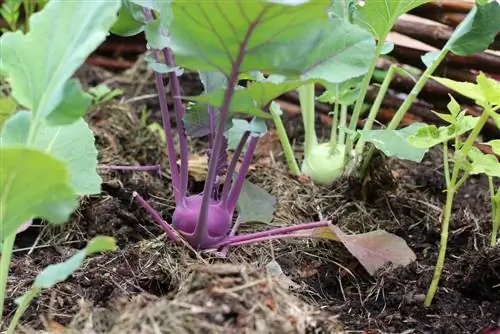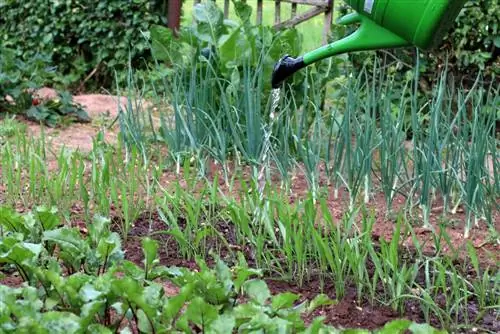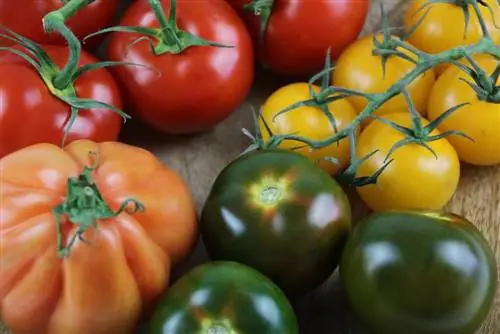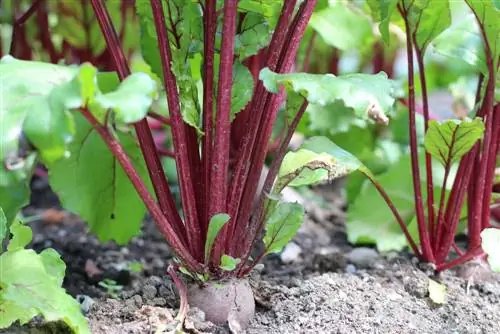- Author admin [email protected].
- Public 2023-12-17 03:39.
- Last modified 2025-01-24 12:45.
As soon as the first warm rays of sunshine finally appear again after a long, cold winter, the hobby gardener's fingers will of course be itching. It's time to prepare the garden and sow the first plants. Traditionally, the gardening year begins with the so-called spring vegetables. As a rule, depending on the weather conditions, it can be put into the ground from March onwards. Typical varieties include iceberg lettuce, spinach and radishes. Not only can they be sown early in the year, but they can also be harvested early.
What are spring vegetables?
There is no exact definition of what is meant by spring vegetables. It is also not a botanical term. Basically, it can be said that all vegetables that are sown or planted early in the spring are considered spring vegetables. In a narrower sense, however, it is about varieties that can cope well with one or two night frosts that are still to be feared. Incidentally, one also speaks of early varieties. Weather and temperatures naturally play a crucial role when sowing spring vegetables. Under normal circumstances, the weather will not be such that cultivation is possible without disruption until March. However, the month is only an approximate guideline. The basic statement that you can sow spring vegetables from March is not true. The decisive factor is the weather.
Tip:
Snow is a good indicator. As long as there is still snow or large amounts of snow in the garden, it is not possible to sow spring vegetables. The ground will then usually still be too cold for the seeds.
The varieties
Spring vegetables can basically be divided into three categories. The first category includes all those varieties that can cope with any night frosts relatively easily. These include iceberg lettuce, lettuce, radishes, kohlrabi and spinach. The second category includes vegetables that are also relatively insensitive to cold, but still need to be protected from frost. Typical representatives are chard, oak leaf lettuce and lollo. Finally, in the third category there is only asparagus. It is also a classic spring vegetable, but represents a special case in that its cultivation requires very special knowledge and is relatively complex. It is therefore only very suitable for hobby gardeners and self-catering enthusiasts.
Basic information about cultivation and care
Spring vegetables are usually sown and not planted. In order for this to work without any problems, the soil in the bed must first be loosened thoroughly with a rake after the winter period. You should also incorporate some compost into the soil. This is especially true if no fertilization was carried out in the fall. In order for the seeds to germinate and grow into plants, they absolutely need water. It is always important to ensure that the soil is relatively moist. If there is little rain, watering must be carried out at this early point in the gardening year. Certain varieties such as chard or oak leaf lettuce also need to be protected from night frost. Here it is advisable to cover the bed with a film. The relatively cold weather in spring also has an advantage: you usually don't have to worry about fighting pests with spring vegetables because they are simply still too fresh for the animals.
The most popular varieties
The list of vegetables that are considered spring vegetables is relatively extensive. However, there are five varieties that are something like the classics. They are therefore also the most popular varieties among gardeners and are typically sown at the beginning of the season:
Kohlrabi
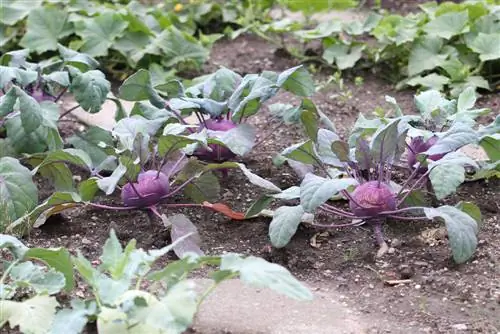
Kohlrabi is relatively insensitive to cold. Its seeds and young plants cope well with temperatures between twelve and 15 degrees Celsius. Under normal circumstances it can therefore be applied to the bed without any problems from mid to late March. From April onwards you should be on the safe side when it comes to temperatures anyway. The basic rule for kohlrabi is that temperatures should not fall below ten degrees for several days. A partially shaded or sunny location is ideal. Kohlrabi does not get along with other types of cabbage. Therefore, no other varieties should have been previously planted in the bed. In order to obtain well-developed tubers that are neither woody nor split open, two crucial factors are important - namely uniform watering and soil that is as nutrient-rich as possible. It is advisable to mulch the soil to create a kind of water reservoir. Constant watering is still necessary. Kohlrabi takes around eight to ten weeks from seed to harvest. It is easy to care for and therefore a very uncomplicated but productive spring vegetable that can be used in a variety of ways in the kitchen. After the first harvest, you can grow again until the first frost.
Iceberg lettuce
The iceberg lettuce also doesn't have too many problems with cold temperatures. It can therefore be sown in the cold frame from March or April. Alternatively, young plants can initially be grown separately in pots. Planting outdoors takes place around mid-April. When sowing, you always sow in rows. The seeds must not be pressed too deeply into the soil. In order for them to germinate, they need the warmth of the sun - and this cannot be achieved if they are too deep in the ground. Once the young plants have reached a height of around ten centimeters, they must be pricked out. This means separating the plants. You prick them out of the ground and plant them again at a greater distance so that they can fully develop later. When it comes to iceberg lettuce, we recommend a distance of around 30 centimeters between the individual plants. The location should always be sunny and the soil should be extremely loose. It is necessary to water regularly as soon as the seeds are sown. In order to thrive, iceberg lettuce needs a lot of water.
Tip:
Protection against pests. The plants magically attract unwanted guests. It is best to stretch a so-called culture net over the entire bed and thus block pests from getting to the lettuce.
Lettuce
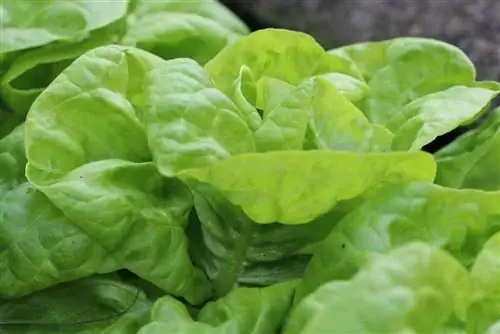
What applies to iceberg lettuce essentially also applies to lettuce. It can also be sown outdoors from mid to late March. As with all types of lettuce, lettuce is usually planted and harvested several times a year. It is always important to have a sunny location, loose soil, regular watering and protection from pests.
Radish
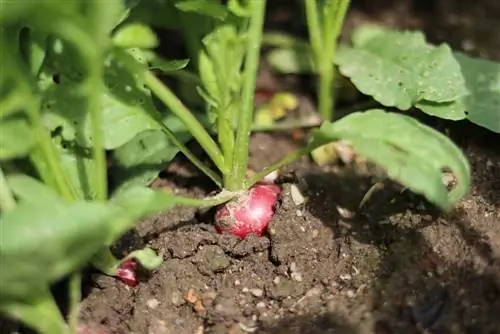
Under normal circumstances, radishes can be sown outdoors from mid-March. The seeds are inserted or pressed into the soil by about a centimeter. The distance between the individual grains should be around four to five centimeters. Sowing in rows is a given. If several rows are planted, there should be a distance of around 15 centimeters between the rows so that the plants can really develop well. Pricking is not necessary for radishes. The location should be sunny, the soil loose and nutrient-rich. Under no circumstances should cucumbers be grown near the radishes, as they draw a lot of water from the soil. Moist soil is important for the small red tubers. However, waterlogging should be avoided. Radishes take about six to eight weeks from sowing to harvesting. They can be grown until autumn. Important: Never sow radish seeds where radishes have already grown. It is also important to avoid the company of cabbage or radishes.
Spinach
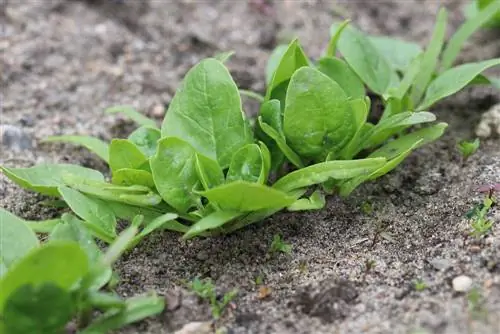
Spinach is a typical spring vegetable that thrives much less well in summer and especially in mid-summer. It can be sown outdoors from mid-March. Partially shaded and sunny locations are best suited for this. It is important to have an adequate supply of water. If there is not enough rainfall, watering is essential. The spinach leaves can usually be harvested about eight weeks after sowing. You should not harvest the spinach hearts themselves. If they remain in place, the leaves will grow back and nothing will stand in the way of at least another harvest. By the way, a second sowing can take place in late summer.

